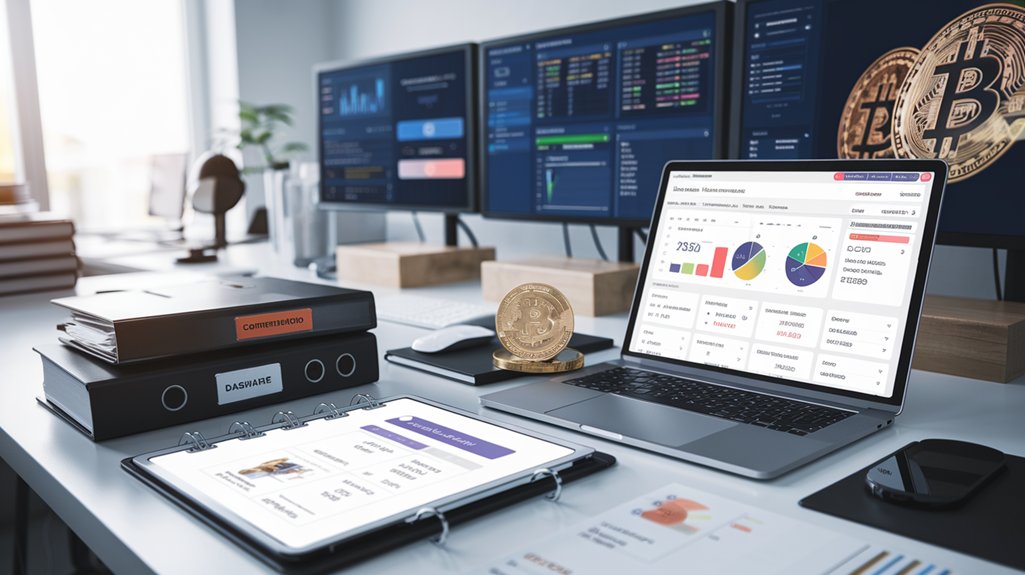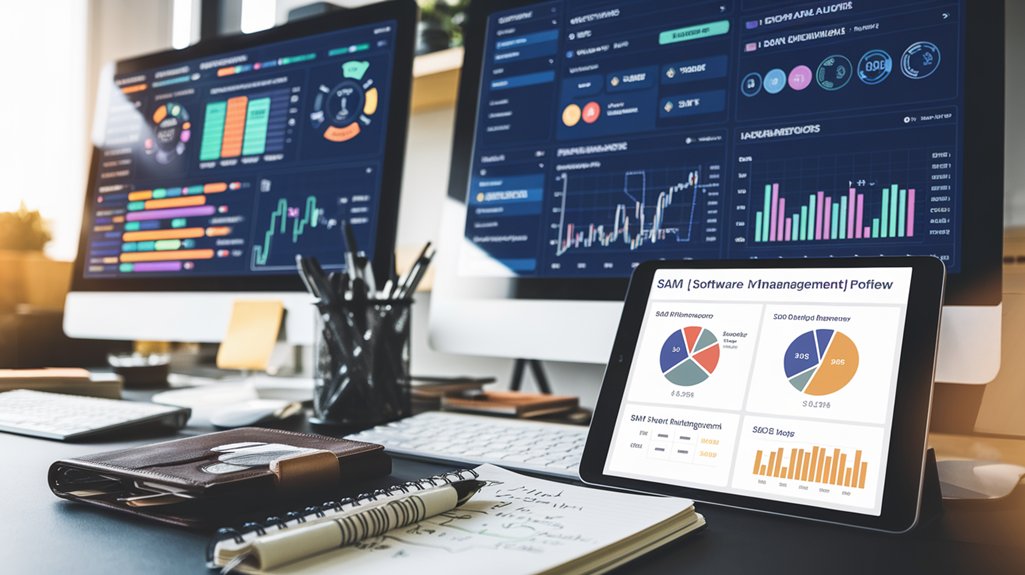Regular SAM profile audits transform compliance activities into strategic business advantages. Organizations should establish a qualified audit team, collect inventory data systematically, and analyze discrepancies between usage and licensing agreements. These reviews can reduce software spending by up to 30% while strengthening security by identifying unauthorized applications. Implementing ongoing monitoring with specialized tools helps prevent wasted expenditure on unused software and maintains regulatory compliance. The following sections outline key implementation steps for maximizing your software investment value.
The Strategic Value of Regular SAM Profile Audits

While many organizations view Software Asset Management (SAM) as merely a compliance requirement, regular SAM profile audits deliver substantial strategic value that extends far beyond basic license tracking.
Establishing appropriate audit frequency guarantees that business decisions align with current software needs and usage patterns, directly supporting strategic goals.
These periodic reviews transform SAM from a reactive compliance tool into a proactive business enabler. Through systematic compliance tracking, organizations can identify cost-saving opportunities, with some reporting up to 30% reduction in software spending in the first year alone.
Strategic SAM audits drive significant cost savings—up to 30% in year one—while transforming compliance into business advantage.
Regular audits also strengthen security posture by flagging unauthorized software and guaranteeing all applications remain properly configured and updated.
Furthermore, SAM profile audits provide executives with accurate data for informed decision-making, positioning IT as a strategic business partner rather than a cost center.
The audit process significantly enhances risk management capabilities by systematically identifying and addressing software vulnerabilities before they can be exploited.
Building a dedicated SAM Center of Excellence can significantly enhance the effectiveness and consistency of periodic profile audits across the organization.
Maintaining federal procurement eligibility through regular SAM reviews ensures organizations remain competitive and compliant with government contracting requirements.
Essential Steps for Effective Audit Implementation

Implementing effective Software Asset Management (SAM) profile audits requires a methodical approach with clearly defined steps and processes. Organizations must begin with thorough audit preparation, establishing clear objectives and guidelines for the audit team to follow. This foundation enables a structured compliance strategy that addresses both immediate and long-term software management needs. Federal contractors can maintain their competitive edge by ensuring their SAM profiles are regularly reviewed and updated.
The implementation process should include:
- Building a qualified audit team with proper training
- Systematically gathering software inventory and license data
- Analyzing discrepancies between usage and licensing agreements
- Developing corrective actions for compliance issues
After completing the initial audit, organizations must implement ongoing monitoring procedures using specialized SAM tools. Regular audits help prevent the wasted expenditure on unused software applications that costs businesses billions annually. These continuous reviews help maintain compliance while optimizing software expenditures through better license management and elimination of redundant applications. Maintaining comprehensive inventory records is crucial for minimizing software-related risks and supporting effective audit outcomes.
Leveraging Audit Findings to Optimize Software Investments

Transforming audit findings into strategic business value represents a critical step in the software asset management process. Organizations can utilize data analytics to identify underutilized software, reallocate licenses, and eliminate redundant applications, driving significant investment efficiency.
Through thorough audit reports, IT teams can prioritize remediation efforts by focusing on high-risk areas first, ensuring resources are allocated effectively. Maintaining data accuracy requirements throughout the registration process helps prevent potential compliance violations and penalties.
Prioritizing high-risk remediation ensures efficient resource utilization while addressing critical vulnerabilities first.
Software optimization occurs when companies implement detailed action plans based on audit discoveries, addressing compliance gaps while simultaneously enhancing performance. Engaging third party experts for a complete license position assessment can illuminate hidden compliance issues before formal vendor audits begin.
Collecting and verifying software licensing agreements can prevent unbudgeted expenses that often result from external audits finding discrepancies.
Collaboration between internal audit teams and stakeholders creates a foundation for continuous improvement, where regular monitoring validates the effectiveness of implemented changes.
This systematic approach transforms routine compliance activities into strategic opportunities, enabling organizations to maximize their software investments while maintaining regulatory compliance.
Frequently Asked Questions
How Do SAM Audits Differ for Cloud Versus On-Premises Software?
SAM audits differ markedly between cloud and on-premises environments.
Cloud licensing audits are typically conducted remotely with centralized data access, making them more efficient and less intrusive. Cloud providers often share security responsibility, with subscription-based cost models.
In contrast, on-premises audits require physical access to systems, give organizations full control over security, and involve considerable hardware investments.
On-premises solutions offer more customization options but demand greater technical expertise during audits.
What Security Concerns Arise During Remote SAM Audit Procedures?
Remote SAM audit procedures present several significant security challenges.
Remote access connections can be vulnerable to unauthorized interception, potentially exposing sensitive licensing data. Data privacy concerns arise when audit information travels across networks, requiring robust encryption protocols.
Organizations must implement secure authentication methods, VPN technologies, and access controls to protect information during transmission.
Additionally, unmonitored endpoints participating in the audit may harbor vulnerabilities that compromise the integrity of collected data and audit results.
How Does Virtualization Impact Software Licensing Compliance Verification?
Virtualization impacts software licensing compliance verification by creating a complex tracking environment.
While virtualization benefits include resource optimization and cost savings, it introduces significant compliance challenges. Organizations must monitor virtual machine deployments, track software usage across multiple VMs, and understand vendor-specific licensing requirements.
License terms often differ between physical and virtual environments, requiring specialized tools to detect software installations across the virtualized infrastructure. Companies must implement robust processes to prevent non-compliance penalties during audits.
When Should Third-Party Audit Specialists Be Engaged Instead of Internal Teams?
Third-party audit specialists should be engaged when organizations face internal limitations in expertise, resources, or independence.
These external professionals bring specialized knowledge particularly valuable for complex technical assessments, regulatory compliance requirements, or high-risk areas.
Organizations benefit from third party expertise when objectivity is paramount, such as during financial audits or when stakeholder trust must be maintained.
Additionally, when time constraints exist or when specialized tools and methodologies are required, external specialists often deliver more efficient results.
How Do Regulatory Requirements Vary for SAM Audits Across Different Industries?
Regulatory frameworks for SAM audits vary considerably by sector.
Healthcare organizations must comply with HIPAA’s data privacy requirements, while financial institutions follow GDPR and PCI-DSS protocols.
Technology companies focus on IP licensing compliance and NIST cybersecurity standards.
Educational institutions prioritize copyright laws and specialized licensing agreements.
Government entities adhere to FISMA regulations.
These industry standards shape audit scope, frequency, documentation requirements, and security protocols that organizations must implement to maintain compliance.